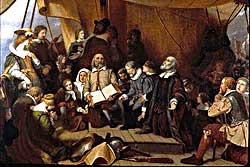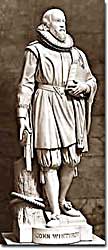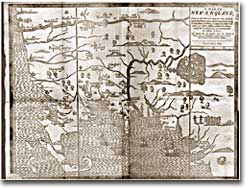Bí quyết Hướng dẫn How did religious differences influence the founding and development of the New England colonies? 2022
Quý quý khách đang tìm kiếm từ khóa How did religious differences influence the founding and development of the New England colonies? 2022-10-08 02:43:07 san sẻ Thủ Thuật về trong nội dung bài viết một cách Chi Tiết.

 Depicting the Pilgrims as they leave Holland for new shores, “The Embarkation of the Pilgrims” can be found on the reverse of a $10,000 bill. Too bad the bill has not been printed since 1946. The founders of the New Religious strife reached a peak in England in the 1500s. When Henry VIII broke with the Catholic Church of Rome, spiritual life in England was Pilgrims and Puritans both believed in the teachings of   John Winthrop was a spiritual and political leader of the Massachusetts Bay Colony. He was elected governor of the colony in 1629. The Stuart family, who ascended to the throne after the demise of Elizabeth, made matters worse for the followers of John Calvin. King James and his son Charles supported the Church of England, but secretly admired the ceremonies of The Pilgrims, called the Separatists in England because of their desire to separate from the Anglican Church, were persecuted by agents of the throne. The Puritans, so named for their desire to purify the Church of England, experienced the same degree of harassment. By the second and third decades of the 1600s, each group decided that England was no place to put  This map, the work of William Hubbard, depicts the expanding New England colonies as they were in 1677. Where else but in the New World could such a golden opportunity be found? The land was unspoiled. Children could be raised without the corruption of old English religious ideas. The chance to create a perfect society was By 1620, the seeds for a new society, quite different from the one already established at Jamestown, were planted deeply within the souls of a few brave pioneers. Their quest would form the basis of New England society.  Part 2 Many of the British North American colonies that eventually formed the United States of America were settled in the seventeenth century by men and women, who, in the face of European persecution, refused to compromise passionately held religious convictions European PersecutionThe religious persecution that drove settlers from Europe to the British North American colonies sprang from the conviction, held by Protestants and Catholics alike, that Execution ofThis engraving depicts the execution of David van der Leyen and Levina Ghyselins, described variously as Dutch Anabaptists or Mennonites, by Catholic authorities in Ghent in 1554. Strangled and burned, van der Leyen was finally dispatched with an iron fork. Bracht’s Martyr’s Mirror is considered by modern Mennonites as second only in importance to the Bible in perpetuating their faith. Murder of David van der Leyen and Levina Ghyselins, Ghent, 1554. Bookmark this item: //www.loc.gov/exhibits/religion/rel01.html#obj001 A Jesuit DisemboweledJesuits like John Ogilvie (Ogilby) (1580-1615) were John Ogilvie (Ogilby), Societas Jesu, 1615. Engraving from Mathias Tanner, Societas Jesu usque ad sanguinis et vitae profusionem Militans. . . . Prague: Typis Universitatis Carolo-Ferdinandeae, 1675. Rare Book and Special Bookmark this item: //www.loc.gov/exhibits/religion/rel01.html#obj004 The Expulsion of the SalzburgersOn October 31, 1731, the Catholic ruler of Salzburg, Austria, Archbishop Leopold von Firmian, issued an edict expelling as many as 20,000 Lutherans from his principality. Many propertyless Lutherans, given only eight days to leave their homes, froze to death as they drifted through the winter Lutherans leaving Salzburg, 1731. Engraving by David Böecklin from Die Freundliche Bewillkommung Leipzig: 1732. Rare Books Division. The Thành Phố New York Public Library, Astor, Lenox and Tilden Foundations (7) Bookmark A Pair of Salzburgers, Fleeing Their HomesThese religious refugees flee Salzburg carrying with them religious volumes. The man has under one arm a copy of the Augsburg Confession; under the other is a theological work by Johann Arndt (1555-1621). The woman is carrying the Bible. The legend between them says: “We are driven into exile for the Gospel’s sake; we leave our homeland and are now in God’s Salzburgische Emigranten. [left page] [right page] Engraving from [Christopher Sancke?], Ausführliche Historie derer Emigranten oder Vertriebenen Lutheraner aus dem Erz-Bistum Salzburg, Leipzig: 1732. Rare Book and Special Collections Division, Library of Congress (8) Bookmark this item: Back to top Persecution of Huguenots by CatholicsThe slaughter of Huguenots (French Protestants) by Catholics at Sens, Burgundy in 1562 occurred at the beginning of more than thirty years of religious strife between French Protestants and Catholics. These wars produced numerous atrocities. The worst was the Massacre Bookmark this item: //www.loc.gov/exhibits/religion/rel01.html#obj002 Persecution of Catholics by HuguenotsIn the areas of France they controlled, Huguenots at least matched the harshness of the persecutions of their Catholic opponents. Atrocities A, B, and C, depictions that are possibly exaggerated for use as propaganda, are located by the author in St. Macaire, Gascony. In scene A, a priest is disemboweled, his entrails wound up on a stick until they are torn out. In illustration B a priest is buried alive, and in C Catholic children are Frightful Outrages perpetrated by the Huguenots in France. Engraving from Richard Verstegen, Thèâtre des Cruautez des Bookmark this item: //www.loc.gov/exhibits/religion/rel01.html#obj003 Drowning of ProtestantsShown here is a depiction of the murder by Irish Catholics of approximately one hundred Protestants from Loughgall Parish, County Armagh, at the bridge over the River Bann near Portadown, Ulster. This atrocity occurred at the beginning of the Massacre of the Protestant Martyrs at the Bridge over the River Bann in Ireland, 1641. Engraving from Matthew Taylor, England’s Bloody Tribunal: Or, Popish Cruelty Displayed . . . . London: J. Cooke, 1772. Bookmark this item: //www.loc.gov/exhibits/religion/rel01.html#obj005 Persecution of Jesuits in EnglandIn the image on the left is Brian Cansfield (1581-1643), a Jesuit priest seized while at prayer by English Protestant authorities in Yorkshire. Cansfield was beaten and imprisoned under harsh conditions. He died on Die Societas Jesu in Europa, 1643-1644 [left page] [right page] from Mathias Tanner, Die Gesellshafft Jesu biss zur vergiessung ihres Blutes wider den Gotzendienst Unglauben und Laster . . . Prague: Carlo Bookmark this item: //www.loc.gov/exhibits/religion/rel01.html#obj006 Martyrdom of John RogersThe execution in 1555 of John Rogers (1500-1555) is portrayed here in the 9th edition of the famous Protestant martyrology, Fox’s Book of Martyrs. Rogers was a The Burning of Master John Rogers. Engraving from John Fox, Bookmark this item: //www.loc.gov/exhibits/religion/rel01.html#obj009 John Rogers Portrayed in New EnglandTwo centuries after John Rogers’s execution, his Bookmark this item: //www.loc.gov/exhibits/religion/rel01.html#obj010 Back to top Crossing the Ocean to Keep the Faith: The PuritansPuritans were English Protestants who wished to reform and purify the Church of England of what they considered to be unacceptable residues of Roman Beginning in 1630 as many as 20,000 Puritans emigrated to America from England to gain the liberty to worship God as they chose. Most settled in New England, but some went as far as the West Indies. Theologically, the Puritans were “non-separating Congregationalists.” Unlike the Pilgrims, who came to Massachusetts in 1620, the Puritans believed that the Church of England was a true church, though in need of major reforms. Every New Richard MatherRichard Mather Richard Mather. Relief cut by John Foster. Copyprint. c. 1670. Courtesy Bookmark this item: //www.loc.gov/exhibits/religion/rel01.html#obj011 Cotton MatherCotton Mather (1663-1728), the best-known New England Puritan divine of his generation, was a controversial figure in his own time and remains so among scholars today. A formidable intellect and a prodigious writer, Mather published some 450 books and pamphlets. He was at the center of all of the
Bookmark this item: //www.loc.gov/exhibits/religion/rel01.html#obj012 Back to top The Bible CommonwealthsThe New England colonies have often been called The Geneva BibleThe Geneva Bible was published in English in Geneva in 1560 by English reformers who fled to the continent to Bookmark this item: //www.loc.gov/exhibits/religion/rel01.html#obj014 The King James BibleThe first edition of the King James Bible, also called the “Authorized Version,” was composed by a committee of English scholars between 1607 and 1611. The first copy of the King James Bible known to have been brought into the colonies was carried by John Winthrop to Massachusetts in 1630. Gradually the King James Bookmark this item: //www.loc.gov/exhibits/religion/rel01.html#obj015 Seventeenth-Century Laws of MassachusettsCriminal laws in the early New England The General Laws and Liberties of the Massachusets Colony: Revised and Reprinted [left page] [right page] Cambridge, Massachusetts: Samuel Green, 1672. Law Library, Rare Book Collection, Library of Congress (16) Bookmark this item: //www.loc.gov/exhibits/religion/rel01.html#obj016 The Bay Psalm BookThe first book published in Bookmark this item: //www.loc.gov/exhibits/religion/rel01.html#obj017 Eliot’s Algonquin Language BibleObedient to the New Testament command to preach the Gospel to all nations, ministers in The Holy Bible: Containing Bookmark this item: //www.loc.gov/exhibits/religion/rel01.html#obj018 Back to top Part 2 What colony developed because of religious differences in New England?Puritans facing religious persecution in England set out for the New World, where they established a colony at Plymouth. How did religious persecution lead to the founding of the New England colonies?European Persecution. The religious persecution that drove settlers from Europe to the British North American colonies sprang from the conviction, held by Protestants and Catholics alike, that uniformity of religion must exist in any given society. How did religion influence colonization?In some regions, almost all of a colony’s populace was removed from their traditional belief systems and were turned towards the Christian faith, which colonizers used as a justification to exterminate other faiths, enslave natives, and exploit lands and seas. How was religion connected to the government in the New England colonies?Politics and religion were closely linked in Puritan New England. Government leaders were also church members, and ministers often had a great giảm giá of power in Puritan communities. Male church members were the only colonists who could vote. |
Video How did religious differences influence the founding and development of the New England colonies? ?
Một số hướng dẫn một cách rõ ràng hơn về đoạn Clip How did religious differences influence the founding and development of the New England colonies? tiên tiến và phát triển nhất .
ShareLink Download How did religious differences influence the founding and development of the New England colonies? miễn phí
Hero đang tìm một số trong những Chia SẻLink Tải How did religious differences influence the founding and development of the New England colonies? miễn phí.
#religious #differences #influence #founding #development #England #colonies
